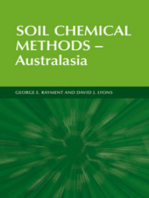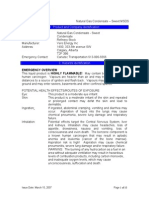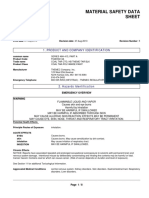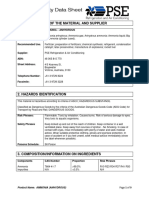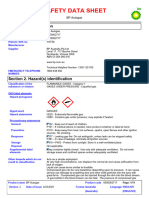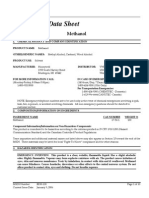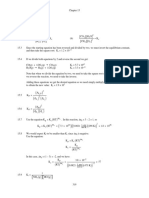Product and Company Identification: Condensate Sweet MSDS Material Safety Data Sheet
Product and Company Identification: Condensate Sweet MSDS Material Safety Data Sheet
Uploaded by
asep supriyadiCopyright:
Available Formats
Product and Company Identification: Condensate Sweet MSDS Material Safety Data Sheet
Product and Company Identification: Condensate Sweet MSDS Material Safety Data Sheet
Uploaded by
asep supriyadiOriginal Description:
Original Title
Copyright
Available Formats
Share this document
Did you find this document useful?
Is this content inappropriate?
Copyright:
Available Formats
Product and Company Identification: Condensate Sweet MSDS Material Safety Data Sheet
Product and Company Identification: Condensate Sweet MSDS Material Safety Data Sheet
Uploaded by
asep supriyadiCopyright:
Available Formats
Condensate Sweet MSDS
Material Safety Data Sheet
1. Product and Company Identification
Product Name: Condensate, Sweet
Synonym: Condensate
Product use: Refinery feedstock
Manufacturer: Keyera
Address: Suite 600, Sunlife Plaza West
144 – 4th Avenue SW
Calgary, AB, T2P 3N4
Emergency Contact: 1-866-377-7110
2. Hazards Identification
EMERGENCY OVERVIEW
This product is highly flammable! Contains benzene, a proven human carcinogen.
Vapors are heavier than air and may travel considerable distances to a source of ignition
and flash back. Vapors may spread along the ground and may enter sewers,
basements, and other confined spaces. Refer to North American Emergency Response
Guide (NAERG) 128.
POTENTIAL HEALTH EFFECTS/ROUTES OF EXPOSURE
Eye: This product is a moderate eye irritant and chronic exposure may
cause reddening of the eye.
Skin: This product is a moderate skin irritant and repeated or prolonged
contact may defat the skin.
Ingestion: If ingested, abdominal cramping, vomiting, and diarrhea may
occur. Aspiration of liquid into the lungs may cause chemical
pneumonia, severe lung damage and respiratory failure.
Inhalation: Potential effects target the Central Nervous System (CNS), liver,
and kidneys. The benzene component is a known human
carcinogen that may result in aplastic anemia and leukemia
(cancer of the bone marrow).
3. Composition/Information on Ingredients
Ingredient Name % CAS No.
Natural gas condensates 100 68919-39-1
Butane(s) 1-5 75-28-5
iso-Pentane 15-30 78-78-4
n-Pentane 15-30 109-66-0
Cyclopentane 1-5 287-92-3
Methylcyclopentane 1-6 96-37-7
n-Hexane 8-20 110-54-3
Cyclohexane 2-5 110-82-7
Methylcyclohexane 1-6 108-87-2
Heptane 5-20 142-82-5
Octane 1-15 111-65-9
Issue Date: June 19, 2009 Page 1 of 8
Condensate Sweet MSDS
Benzene 1-3 71-43-2
Toluene 1-3 108-88-3
Ethylbenzene 0.1-1.5 100-41-4
Xylene 0-3 1330-20-7
1, 2, 4 Trimethylbenzene 0-4 25551-13-7
Condensate is a liquid hydrocarbon product associated with Natural Gas and is used as
refinery feedstock for petroleum products. This product is a commingled stream from
multiple petroleum facilities and is a complex mixture consistent with the definition within
WHMIS regulation CPR section 2. The listed components are provided as guidance
based on the available knowledge of the commingled stream.
4. First Aid Measures
Eyes: In case of contact with eyes, immediately flush with clean, low-
pressure water for at least 20 minutes. Hold eyelids open to
ensure adequate flushing. Seek medical attention.
Skin: Remove contaminated clothing. Wash contaminated areas
thoroughly with soap and water (waterless hand cleanser may be
used if water is not readily available). Obtain medical attention if
irritation or redness develops.
Ingestion: Do not induce vomiting because of the danger of aspiration the
fluid into the lungs. Obtain immediate medical attention.
Inhalation: Ensure your own safety and use the appropriate respiratory
protection to immediately remove the victim to an uncontaminated
area. Give CPR or artificial respiration as needed and give oxygen
if breathing is difficult. Keep victim at rest and get immediate
medical attention.
5. Fire Fighting Measures
FLAMMABLE PROPERTIES
Flammable Liquid
HAZARDOUS COMBUSTION PRODUCTS
During combustion carbon monoxide and/or carbon dioxide may be produced.
FIRE AND EXPLOSION HAZARDS
Product vapors are heavier than air and may travel considerable distances to sources of
ignition and flash back. Vapors may spread along the ground and may enter sewers,
basements, and other confined spaces. Vapors can be easily ignited by heat, sparks, or
flames.
EXTINGUISHING MEDIA
Small Fires: Dry chemical, CO2, water spray or regular foam.
Large Fires: Water spray, fog or regular foam. Use water spray or fog; do not use
straight streams. Move containers from fire area if possible without risk.
FIRE FIGHTING INSTRUCTIONS:
Water may be ineffective for fighting the fire, but may be used to cool fire-exposed
containers. Consider initial downwind evacuation for at least 800 meters (1/2 mile). Cool
containers with large quantities of water until well after the fire has been put out. Do not
Issue Date: June 19, 2009 Page 2 of 8
Condensate Sweet MSDS
direct the water stream at the source of the leak. Withdraw immediately in case of rising
sound from venting safety devices or discoloration of tank. ALWAYS stay away from
tanks engulfed in fire. Fight fires from maximum distance and for massive fires, use
unmanned hose holders or monitor nozzles. If this is not possible, withdraw from the
area and let the fire burn. Approved self-contained breathing apparatus (SCBA) with full-
face piece and full protective firefighting clothing should be worn.
If tank, rail car or tank truck is involved in a fire, ISOLATE for 800 meters (1/2 mile) in all
directions; also, consider initial evacuation for 800 meters (1/2 mile) in all directions.
UNUSUAL FIRE & EXPLOSION HAZARDS
Product floats on water and is capable of creating a fire hazard along path of runoff.
6. Accidental Release Measures
ACTIVATE SITE SPECIFIC EMERGENCY RESPONSE PLAN, IF AVAILABLE.
Small Spills: Ensure your own safety and use the appropriate respiratory protection.
An approved self-contained breathing apparatus (SCBA) with full-face piece may be
required. Remove all ignition sources. Ventilate the area and attempt to stop the leak if
possible without risk. Do not attempt to extinguish a fire unless the leak can be stopped.
Large Spills: Ensure your own safety and use the appropriate respiratory protection.
An approved self-contained breathing apparatus (SCBA) with full-face piece may be
required. Isolate spill or leak area immediately for at least 300 meters (1000 feet) in all
directions. Keep unauthorized personnel away and stay upwind. Keep out of low areas;
many vapors are heavier than air and will spread along ground and collect in low or
confined areas (sewers, basements, tanks). Do not discharge solid water stream pattern
into the liquid resulting in splashing. Do not flush down sewer or drainage systems; if
possible protect bodies of water by dyking. For large spills, recover liquid and remove
contaminated earth, place suitable absorbent materials into closed containers for
approved disposal.
Evacuation: Fire: If tank, rail car or tank truck is involved in a fire, ISOLATE for 800
meters (1/2 mile) in all directions; also, consider initial evacuation for 800 meters (1/2
mile) in all directions.
Caution: Ensure your own safety and use the appropriate respiratory protection. An
approved self-contained breathing apparatus (SCBA) with full-face piece may be
required. Consideration should be given to environmental clean-up and waste material
generation when deciding if the use of large volumes of water is appropriate for non-fire
emergency situations. Clean-up crews must be properly trained and must utilize proper
protective equipment.
7. Handling and Storage
HANDLING PRECAUTIONS
Ensure your own safety and use the appropriate respiratory protection. An approved
self-contained breathing apparatus (SCBA) with full-face piece may be required. Handle
as a flammable liquid. Keep away from all sources of heat, sparks, open flame or any
sources of ignition, as well as flammable materials or oxidizers. Do not pressurize, cut,
heat, weld or expose such containers to sources of ignition. Use only with adequate
Issue Date: June 19, 2009 Page 3 of 8
Condensate Sweet MSDS
ventilation and avoid breathing vapors. Ground and bond all lines and equipment.
Electrical equipment must be approved for classified areas. DO NOT siphon by mouth.
STORAGE PRECAUTIONS
Store in a cool, dry, ventilated area, out of sunlight and away from all sources of heat
and ignition sources. Avoid storage in low, confined locations or near incompatible
materials such as other flammable materials, oxidizers or materials that support
combustion. Reference the applicable standards for safe storage practices of petroleum
products.
WORK/HYGIENIC PRACTICES
An emergency eye wash station should be available in the vicinity of any potential splash
exposure. Use good personal hygiene practices. Avoid skin exposure and wash hands
before eating, drinking, smoking, or using toilet facilities. Do not eat, drink or smoke in
areas of use or storage. Promptly remove contaminated clothing and launder before
reuse. Use care when laundering to prevent the formation of flammable vapors which
could ignite via washer or dryer.
8. Exposure Controls / Personal Protection
ENGINEERING CONTROLS
Ensure your own safety and use the appropriate respiratory protection. An approved
self-contained breathing apparatus (SCBA) with full-face piece may be required. Ensure
adequate ventilation to keep vapor and gas concentrations of this product below
occupational exposure and flammability limits, particularly in confined spaces. Electrical
equipment including ventilation systems should be approved for classified areas.
Showers and/or eyewash fountains should be provided within the immediate work area
for emergency use when there is any possibility of exposure to liquids.
PERSONAL PROTECTIVE EQUIPMENT
Eye/Face Protection: Wear chemical goggles or a full-face shield when handling this
product.
Skin Protection: Avoid contact with skin. Wear appropriate fire retardant and chemical
resistant gloves when handling this product.
Respiratory Protection: Ensure your own safety and use the appropriate respiratory
protection. An approved organic vapour respirator with face-piece appropriate for
concentrations the concentration exceeds the OEL (Occupational Exposure Limit).
When assessing the proper type of respiratory protection consider the occupational
exposure limits applicable to individual ingredients. Refer to CSA Standard “Selection,
Use and Care of Respirators” (Z94.4-02) and NIOSH Respirator Decision Logic for
additional guidance on respiratory protection.
Issue Date: June 19, 2009 Page 4 of 8
Condensate Sweet MSDS
Exposure Limits
Ingredient Name CAS No. Occupational Exposure Limits
Natural gas condensates 68919-39-1 Not applicable
n-Butane 75-28-5 ACGIH TLV-TWA =1000ppm
iso-Pentane 78-78-4 ACGIH TLV-TWA =600ppm
n-Pentane 109-66-0 ACGIH TLV-TWA =600ppm
Cyclopentane 287-92-3 ACGIH TLV-TWA =600ppm
Methylcyclopentane 96-37-7 Not applicable
n-Hexane 110-54-3 ACGIH TLV-TWA =50ppm (skin)
Cyclohexane 110-82-7 ACGIH TLV-TWA =100ppm
Methylcyclohexane 108-87-2 ACGIH TLV-TWA =400ppm
Heptane 142-82-5 ACGIH TLV-TWA =400ppm
ACGIH TLV-STEL =500ppm
Octane 111-65-9 ACGIH TLV-TWA =300ppm
Benzene 71-43-2 ACGIH TLV-TWA =0.5ppm (skin)
ACGIH TLV-STEL =2.5ppm
Toluene 108-88-3 ACGIH TLV-TWA =600ppm
Ethylbenzene 100-41-4 ACGIH TLV-TWA =100ppm
ACGIH TLV-STEL =125ppm
Xylene 1330-20-7 ACGIH TLV-TWA =600ppm
1, 2, 4 Trimethylbenzene 25551-13-7 ACGIH TLV-TWA =25ppm
ACGIH – American Conference of Governmental Industrial Hygienists
TLV – Threshold Limit Value
TWA – Time Weighted Average
STEL – Short Term Exposure Limits
9. Physical and Chemical Properties
Appearance and state: Pale yellow to brown liquid
Odour: Hydrocarbon
Odour Threshold: Not available
Flash Point: <-35oC (Closed Cup)
Auto Ignition: 260oC (n-Pentane)
Lower Explosive Limit (%): 1.5 (n-Pentane)
Upper Explosive Limit (%): 7.8 (n-Pentane)
Boiling Point: >28oC
Melting Point: Not available
Vapor Pressure: 103 kPA @ 37.8oC
Vapor Density (Air = 1): >1
Viscosity: Not available
Specific Gravity: 0.65-0.67
Solubility (H2o): Slight
Percent Volatiles: 100%
Evaporation Rate: Not available
Issue Date: June 19, 2009 Page 5 of 8
Condensate Sweet MSDS
10. Stability and Reactivity
STABILITY
Stable
CONDITIONS TO AVOID (STABILITY)
Material is stable under normal conditions but can rapidly become volatile. Avoid high
temperatures, open flames, sparks, welding, smoking, and other ignitions sources.
INCOMPATIBLE MATERIALS
Keep away from strong oxidizers, ignition sources, and heat.
HAZARDOUS DECOMPOSITION PRODUCTS
Irritating or toxic substances may be emitted upon thermal decomposition.
Decomposition products include carbon dioxide and carbon monoxide.
HAZARDOUS POLYMERIZATION
Will not occur
11. Toxicological Information
Chemical Name CAS No. LD50 LC50
Butane(s) 75-28-5 Not available Rat:658 mg/l/4Hrs
iso-Pentane 78-78-4 Not available Mouse: 14000 ppm
n-Pentane 109-66-0 Mouse (ivn): 446 Rat: 364 gm/m3 (4Hr)
mg/kg
Cyclopentane 287-92-3 Not available Not available
Methylcyclopentane 96-37-7 Not available Not available
n-Hexane 110-54-3 Rat (oral): 43.5 Mouse inhalation
mg/kg BW 48000 ppm/4 hr
Cyclohexane 110-82-7 Rat oral 8.0 Not available
mL/kg
Methylcyclohexane 108-87-2 Not available Not available
Heptane 142-82-5 Mouse, iv Not available
222 mg/kg
Octane 111-65-9 Not available Rat inhalation
118 g/cu m/4 hr
Benzene 71-43-2 Rat (oral): Rat ihl: 10,000 ppm
3306mg.kg 7hr
Toluene 108-88-3 Rat oral 5000 rats 8000 ppm for 4 hr.
mg/kg
Ethylbenzene 100-41-4 Rat oral 3500 Not available
mg/kg
Xylene 1330-20-7 LD50 Rat oral 4.3 Not available
g/kg
1, 2, 4 Trimethylbenzene 25551-13-7 Rat, oral 8970 Not available
mg/kg
Issue Date: June 19, 2009 Page 6 of 8
Condensate Sweet MSDS
POTENTIAL HEALTH EFFECTS
Acute effects: Low concentrations may irritate eyes, skin, respiratory system, Central
Nervous System (CNS), and peripheral nervous system. May cause CNS depression,
cardiac sensitization, drowsiness, narcosis, and asphyxia.
Chronic effects: Potential chronic effects to this product include peripheral neuropathy
and blurred vision. Chronic exposure has resulted in aplastic anemia, acute myoblastic
leukemia, bone marrow depression, corneal vacuolization erythroleukemia, and even
death.
Sensitization: Butane is linked with cardiac sensitization.
Mutagenicity: Benzene is a weak mutagen.
Reproductive effects: Spontaneous abortion is possible for women exposed to
Toluene during pregnancy. Benzene exposure has been linked to menstrual changes,
spontaneous abortion and stillbirth. Xylene is embryotoxic.
Carcinogenicity: Benzene carcinogenic listings are as follows: Known Carcinogen
NTP, Known Human Carcinogen IARC Group 1 proven and Confirmed Human
Carcinogen ACGIH A1. Ethylbenzene is classified as a Possible Carcinogen IARC 2B.
Target organs: Central nervous system (CNS), heart, blood forming systems, liver and
kidneys, gastrointestinal tract and respiratory system.
12. Ecological Information
If released into soil, this product will absorb and may biodegrade in anaerobic conditions.
In water, it may become volatile. Photo-oxidation products include phenol, nitrophenols,
nitrobenzene, formic acid and peroxyacetyl nitrate.
13. Disposal Considerations
Maximize product recovery for reuse or recycling. Contaminated materials may be
classified as a hazardous waste due to the low flash point and benzene. Empty
containers can have residues that are subject to hazardous waste disposal
requirements. Dispose of waste in accordance with all applicable federal, provincial,
and/or local regulations.
14. Transport Information
PROPER SHIPPING NAME: Petroleum distillate, N.O.S.
TDG CLASS: 3
TDG IDENTIFICATION NUMBER: UN1268
TDG SHIPPING LABEL: Flammable liquid
PACKING GROUP: II
NAERG: Guide 128
Issue Date: June 19, 2009 Page 7 of 8
Condensate Sweet MSDS
15. Regulatory Information
WORKPLACE HAZARDOUS MATERIALS INFORMATION SYSTEM (WHMIS)
Workplace Hazardous Materials Information Systems (WHMIS): This product has been
classified in accordance with the hazard criteria of the CPR (Controlled Product
Regulations), and the MSDS contains all of the information required by the CPR.
Class B3 – Flammable Liquid
Class D2A – Materials Causing Serious and Other Toxic Effects
CANADIAN ENVIRONMENTAL PROTECTION ACT (CEPA)
All components of this product are listed on the Canadian DSL Inventory.
16. Other Information
Prepared for: Keyera Health and Safety
Issue Date: June 19, 2009
More Information: (403) 843-7162
Technical Preparation by: Deerfoot Consulting Inc.
Disclaimer of Expressed and Implied Warranties
The information presented in the Material Safety Data Sheet is based on data believed to be accurate as of
the date this Material Safety Data Sheet was prepared. However, neither Keyera, Deerfoot Consulting Inc
nor any of their subsidiaries assumes any liability whatsoever for the accuracy or completeness of the
information contained herein. No responsibility is assumed for any damage or injury resulting from abnormal
use or from any failure to adhere to recommended practices. The information provided above, and the
product, are furnished on the condition that the person receiving them shall make their own determination as
to the suitability of the product for their particular purpose and on the condition that they assume the risk of
their use.
Issue Date: June 19, 2009 Page 8 of 8
You might also like
- Procedure For Transfer of Bunkers To Vessel - ISO 13739Document50 pagesProcedure For Transfer of Bunkers To Vessel - ISO 13739asep supriyadi100% (2)
- Sherwin Williams Internal Sprays SDSDocument9 pagesSherwin Williams Internal Sprays SDSJoe de Tracy GouldNo ratings yet
- (Albrecht Kaupp PHD (Auth.) ) Gasification of RiceDocument322 pages(Albrecht Kaupp PHD (Auth.) ) Gasification of RiceDaniel GNo ratings yet
- PH Eur 2.4.27. Heavy Metals in Herbal Drugs and Fatty OilsDocument2 pagesPH Eur 2.4.27. Heavy Metals in Herbal Drugs and Fatty OilsLuis SanabriaNo ratings yet
- MSDS Natural Gas Condensate - SweetDocument10 pagesMSDS Natural Gas Condensate - SweetMuhammad Naufal Nazhib KhanNo ratings yet
- Ms Ds NaphthaDocument12 pagesMs Ds NaphthaCatharina Natasa BellaFortunaNo ratings yet
- Sagasolv A 150 MsdsDocument11 pagesSagasolv A 150 MsdsIrfan NgaranaNo ratings yet
- Methyl Ethyl Ketone MSDSDocument15 pagesMethyl Ethyl Ketone MSDSArjunNo ratings yet
- Oil-AW-100 MSDSDocument6 pagesOil-AW-100 MSDSAndres GonzalezNo ratings yet
- Liquefied Petroleum Gas (LPG) : 1. Identification of The Material and SupplierDocument6 pagesLiquefied Petroleum Gas (LPG) : 1. Identification of The Material and SupplierstefenandreanNo ratings yet
- 2016 (3) Anionic Slow Setting EmulsionDocument6 pages2016 (3) Anionic Slow Setting EmulsionRanmal AbhaNo ratings yet
- Tnemec (MSDS) Series 46h-413Document15 pagesTnemec (MSDS) Series 46h-413PubcrawlNo ratings yet
- Ms Ds BiodieselDocument10 pagesMs Ds BiodieselOsckar DezNo ratings yet
- MSDS SIGMAWELD 165 (SIGMA PROFERRAL MC) PASTE (ENG) (sk-17-03-07leg-MT)Document7 pagesMSDS SIGMAWELD 165 (SIGMA PROFERRAL MC) PASTE (ENG) (sk-17-03-07leg-MT)Eyoh EffiongNo ratings yet
- Https WWW - Petron.com Wp-Content Uploads 2018 06 MSDS Petron XCS PDFDocument5 pagesHttps WWW - Petron.com Wp-Content Uploads 2018 06 MSDS Petron XCS PDFFrancis SalongaNo ratings yet
- R717 (Ammonia) - (MSDS)Document9 pagesR717 (Ammonia) - (MSDS)syed sameer mustafaNo ratings yet
- Kerosene PDFDocument9 pagesKerosene PDFishnafathonahNo ratings yet
- Non Acetone Nailpolish RemoverDocument18 pagesNon Acetone Nailpolish RemoverCarolinaNo ratings yet
- MsdsbiodieselDocument10 pagesMsdsbiodieselHafid AlwanNo ratings yet
- Safety Data Sheet: Section 1 - Identification: Product Identifier and Chemical IdentityDocument6 pagesSafety Data Sheet: Section 1 - Identification: Product Identifier and Chemical IdentityFathianPujakesumaNo ratings yet
- Material Safety Data Sheet Tenkoz Cypermethrin Insecticide Section 1 Chemical Product and Company IdentificationDocument4 pagesMaterial Safety Data Sheet Tenkoz Cypermethrin Insecticide Section 1 Chemical Product and Company IdentificationzpmNo ratings yet
- Flash Point Int Green DieselDocument8 pagesFlash Point Int Green DieselAnggya AnggyNo ratings yet
- BP AutogasDocument11 pagesBP Autogaslisapl.limNo ratings yet
- HSD PDFDocument7 pagesHSD PDFsaqibNo ratings yet
- Hfo Msds ShellDocument9 pagesHfo Msds ShellLiam MoylanNo ratings yet
- Acetylene Gas C2H2 Safety Data Sheet SDS P4559Document10 pagesAcetylene Gas C2H2 Safety Data Sheet SDS P4559pranksterboyNo ratings yet
- Safety Data Sheet: DieselDocument8 pagesSafety Data Sheet: DieselSandra CastilloNo ratings yet
- SDS Asphalt Emulsions CSS-1 & CSS-1hDocument9 pagesSDS Asphalt Emulsions CSS-1 & CSS-1hTorero02No ratings yet
- Material Safety Data Sheet: 1. Identification of The Substance/Preparation and of The Company/UndertakingDocument9 pagesMaterial Safety Data Sheet: 1. Identification of The Substance/Preparation and of The Company/UndertakingEetu SatosalmiNo ratings yet
- Safety Data Sheet ACTANE 4322 (QA) : 1. Identification of The Substance/Preparation and The CompanyDocument7 pagesSafety Data Sheet ACTANE 4322 (QA) : 1. Identification of The Substance/Preparation and The CompanyUtilities2No ratings yet
- Liquefied Petroleum Gas (LPG) : Safety Data SheetDocument8 pagesLiquefied Petroleum Gas (LPG) : Safety Data SheetHSE PLMB Lotus ProjectNo ratings yet
- Troymax BXPB-iDocument2 pagesTroymax BXPB-iPetrus BetanNo ratings yet
- MSDS White GreaseDocument10 pagesMSDS White GreaseAndini Nur Paujiah100% (1)
- Exxsol D60Document10 pagesExxsol D60Adi WiraNo ratings yet
- Methanol MSDS PDFDocument10 pagesMethanol MSDS PDFPutriErvinaNo ratings yet
- Msds Jet A1 Shell CurrentDocument6 pagesMsds Jet A1 Shell Currentviktor_gligorovNo ratings yet
- Msds English WiO - Class 3 (Water in Oil Reagent) CastrolDocument5 pagesMsds English WiO - Class 3 (Water in Oil Reagent) Castrolcruz.rafaela89No ratings yet
- Msds SIGMAZINC 109 (SIGMARITE ZINC PRIMER) BASE (ENG) (sk-17-03-07leg-MT)Document8 pagesMsds SIGMAZINC 109 (SIGMARITE ZINC PRIMER) BASE (ENG) (sk-17-03-07leg-MT)Eyoh EffiongNo ratings yet
- Styrene MonomerDocument7 pagesStyrene MonomertayplastNo ratings yet
- MSDS Petron Diesel MaxDocument5 pagesMSDS Petron Diesel MaxDomsNo ratings yet
- HexaneDocument15 pagesHexanekimuasNo ratings yet
- Silva SparDocument10 pagesSilva Sparsergey.shushkanov1986No ratings yet
- Thpu-71362 M (Msds - Eng) - ThinnerDocument4 pagesThpu-71362 M (Msds - Eng) - ThinnerbabimasaksawiNo ratings yet
- MSDS Gasoline by HESS (2007)Document9 pagesMSDS Gasoline by HESS (2007)Torero02No ratings yet
- CR-06026Document7 pagesCR-06026LucesitaNo ratings yet
- MSDS Nippelux-1901-Reducer - SDS-140317Document9 pagesMSDS Nippelux-1901-Reducer - SDS-140317Ricky SeptianNo ratings yet
- MSDS Particulas MagneticasDocument8 pagesMSDS Particulas MagneticasCarmen Rosa Montes MarcosNo ratings yet
- 105 - KeroseneDocument13 pages105 - Keroseneloveanbu24No ratings yet
- BP Biodiesel Blend MsdsDocument6 pagesBP Biodiesel Blend MsdsFurkan YamanNo ratings yet
- Annexure-1 PSO HSD MSDSDocument7 pagesAnnexure-1 PSO HSD MSDSMOL Team LeadNo ratings yet
- Solvent C 9: Page 1 of 15Document15 pagesSolvent C 9: Page 1 of 15Elder Andrades MartinezNo ratings yet
- Msdsisomerate Msds Mixed PentanesDocument10 pagesMsdsisomerate Msds Mixed PentanesEmman Patpert KnuckleheadsNo ratings yet
- I PAaDocument8 pagesI PAaabriaNo ratings yet
- 0098 T8f8c5kubDocument5 pages0098 T8f8c5kubNandar Min HtetNo ratings yet
- Tert-Butyl Acrylate MSDSDocument17 pagesTert-Butyl Acrylate MSDSrezaNo ratings yet
- Material Safety Data Sheet: 1. Chemical Product and Company IdentificationDocument7 pagesMaterial Safety Data Sheet: 1. Chemical Product and Company IdentificationVo Anh HaoNo ratings yet
- Liquefied Petroleum Gas (Lpgas) : Safety Data SheetDocument8 pagesLiquefied Petroleum Gas (Lpgas) : Safety Data Sheetnuke apriyaniNo ratings yet
- Safety Data Sheet: Section 1 - Product and Company IdentificationDocument9 pagesSafety Data Sheet: Section 1 - Product and Company Identificationbcsf01No ratings yet
- Contemporary Anaesthetic Equipments.: An Aid for Healthcare ProfessionalsFrom EverandContemporary Anaesthetic Equipments.: An Aid for Healthcare ProfessionalsNo ratings yet
- After a Disaster - Information to Help You and Your Family RecoverFrom EverandAfter a Disaster - Information to Help You and Your Family RecoverNo ratings yet
- Specification PetroleumDocument19 pagesSpecification Petroleumasep supriyadiNo ratings yet
- MSDS - Base Oil SBS 150Document3 pagesMSDS - Base Oil SBS 150asep supriyadiNo ratings yet
- Gas Oil: Section 1 - Chemical Product and Company IdentificationDocument10 pagesGas Oil: Section 1 - Chemical Product and Company Identificationasep supriyadiNo ratings yet
- Low Sulphur Fuel Oil (LSFO)Document7 pagesLow Sulphur Fuel Oil (LSFO)asep supriyadiNo ratings yet
- ASTM D-4052 Density, Relatif Density and API by Digital Density MeterDocument8 pagesASTM D-4052 Density, Relatif Density and API by Digital Density Meterasep supriyadi100% (1)
- Silicones Additives 2017Document36 pagesSilicones Additives 2017Bilson ShuklaNo ratings yet
- Organic ChemistryDocument11 pagesOrganic ChemistrySanket AtkariNo ratings yet
- Preparation and Quality Assessment of Orange (Citrus: Reticulata L.) Peel CandyDocument6 pagesPreparation and Quality Assessment of Orange (Citrus: Reticulata L.) Peel CandyKairo ScheveNo ratings yet
- Natural Floor Cleaner and Insect RepellentDocument6 pagesNatural Floor Cleaner and Insect RepellentblancojilliannegraceNo ratings yet
- TDS - Pioneer Mighty Gasket Black - 022019Document2 pagesTDS - Pioneer Mighty Gasket Black - 022019wendel raguindinNo ratings yet
- Felisberto CAMUEGE Extended AbstractDocument13 pagesFelisberto CAMUEGE Extended AbstractEbenleslie Baffoe-BonnieNo ratings yet
- Crude Oil Presentation - Chemistry 243Document23 pagesCrude Oil Presentation - Chemistry 243Tishonna DouglasNo ratings yet
- Thin-Layer ChromatographyDocument47 pagesThin-Layer ChromatographySubhradeep GhoshNo ratings yet
- Kinetics of Acidic Potassium PermanganateDocument9 pagesKinetics of Acidic Potassium PermanganateALYESSA EVALOU AUGGASNo ratings yet
- Chemistry GuidelineDocument59 pagesChemistry GuidelineelishamahubiNo ratings yet
- ch15 PDFDocument29 pagesch15 PDFHafidz RafiqiNo ratings yet
- HKISO 2019-2020 - Mock - Heat - S1fDocument9 pagesHKISO 2019-2020 - Mock - Heat - S1fSuzanna H. PrasetyoNo ratings yet
- Struktol Brochure Eng 2011Document40 pagesStruktol Brochure Eng 2011Elizabeth MaryNo ratings yet
- WEATHERPROOF BLV 2X36 T-LED TUBE ARTOLITE 2x 18WDocument1 pageWEATHERPROOF BLV 2X36 T-LED TUBE ARTOLITE 2x 18Wrizkylssgk2021No ratings yet
- Teratogenesis by Dr. Otulana - 010215Document10 pagesTeratogenesis by Dr. Otulana - 010215Oloruntomi AdesinaNo ratings yet
- ChemCAD Course 2008 K-VALUE OPTIONSDocument4 pagesChemCAD Course 2008 K-VALUE OPTIONSVictor R VazquezNo ratings yet
- Ekaland & Vultac® Range For Rubber Application: P P P PDocument1 pageEkaland & Vultac® Range For Rubber Application: P P P Pjulius hasan33No ratings yet
- Detergents PDFDocument10 pagesDetergents PDFThirumani SelvamNo ratings yet
- Soil Stabilization MethodsDocument27 pagesSoil Stabilization MethodsHarrajdeep SinghNo ratings yet
- Subject: Chemistry Form: 4 Year: 2016: Quantity JPNJ Standard School StandardDocument22 pagesSubject: Chemistry Form: 4 Year: 2016: Quantity JPNJ Standard School StandardFatimahHishamuddinNo ratings yet
- Custom House, ChittagongDocument20 pagesCustom House, Chittagongsamrat_77100% (1)
- Notes 6.1Document3 pagesNotes 6.1LEE LEE LAUNo ratings yet
- Problemas Lección 1. Representaciones Moleculares y NomenclaturaDocument7 pagesProblemas Lección 1. Representaciones Moleculares y NomenclaturaRubén Ariza GarcíaNo ratings yet
- APPSC Sample Taker in AP Institute of Preventive Medicine Exam GS 19-08-2023Document74 pagesAPPSC Sample Taker in AP Institute of Preventive Medicine Exam GS 19-08-2023RaghuNo ratings yet
- DF Dursban MSDS PDFDocument10 pagesDF Dursban MSDS PDFkeshav chaturvediNo ratings yet
- Gelatin and Non-Gelatin Capsule Dosage FormsDocument13 pagesGelatin and Non-Gelatin Capsule Dosage FormsSergio Alberto Bernal Chavez100% (1)
- FOAM MAKING EQUIPMENT - PptxupdateDocument25 pagesFOAM MAKING EQUIPMENT - PptxupdateMathewNo ratings yet
- Uv-Visible Spectroscopy: Presented By: Gabriel Engonga and Flora DikeDocument61 pagesUv-Visible Spectroscopy: Presented By: Gabriel Engonga and Flora DikeGabriel EngongaNo ratings yet


